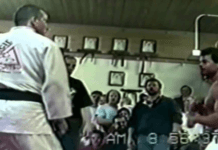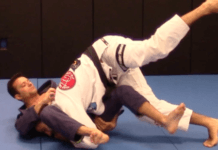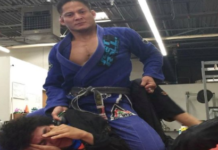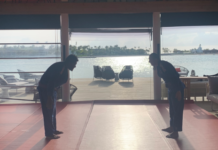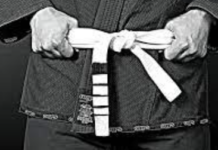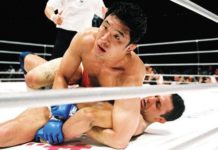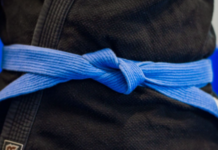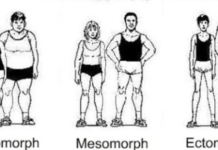The origin of various martial arts is a fascinating subject to ponder over. And the case of Brazilian Jiu-Jitsu is no exception to this. There are many people that would like to know the exact lineage of BJJ. Well, BJJ stems from the incorporation and the refinement of various Judo techniques. And at the essence of Judo is the grandfather of all grappling techniques – Japanese Jiu-Jitsu. Since Brazilian Jiu-Jitsu and Japanese Jiu-Jitsu only differ in terms of their names by virtue of the country they represent – many people are interested if there are any similarities and differences between these martial arts.
Japanese Jiu-Jitsu
Japanese Jiu-Jitsu evolved as a life-or-death system of skills and techniques. They were originally created back in the day of the Samurai warriors and the ninjas. As you may expect, these were people that frequently went to battle in which they risked losing their lives to their opponents. So, it’s clear that they needed a martial arts system that they could use for unarmed combat. And Japanese Jiu-Jitsu was borne out of this need. Today Japanese Jiu-Jitsu is taught in a much more traditional martial arts setting. The traditional values of discipline and hierarchy take precedence.
The name “Ju Jutsu”
The word Jujutsu can be separated into two sections, “Ju” and “Jutsu”. The first part can be translated to “gentle” or “soft”. Whereas “Jutsu” can mean “art” or “technique” This both combined can, therefore, symbolize that this martial art is more about manipulating the opponent’s force against themselves rather than confronting it with one’s own force.
The name Jujutsu is the result of using the standard spelling system for the romanization of Japanese that uses the Latin alphabet to write the Japanese language. However, the names jiu-jitsu or ju-jitsu are more popular. Even though it is unfaithful to the standard Japanese pronunciation. This non-standardized spelling is a result of how English speakers heard the name Jujutsu. For them, it just sounds more like jiu-jitsu or ju-jitsu. Pronouncing it as ju-jitsu is popular mostly in France, Canada, and the United Kingdom while jiu-jitsu is most widely used in Germany and Brazil.
History of Japanese Jiu jitsu
Some researchers say the creation of Ju Jitsu can be dated even back to 772 A.D. and is associated with the formation of the samurai caste. However, others say it can only date back to the Muromachi period in Japan between 1333 and 1573. Other others say that Jujutsu first began during the Sengoku period (c. 1467 – c. 1600). Despite these time inconsistencies Jujutsu is always associated with Samurais and skills they needed in combat. This martial art was focused on teaching the unarmed or very lightly armed warrior to fight a heavily armed warrior. This eventually led to the teaching of a significant amount of grappling, throwing, restraining and weaponry skills. Jiu Jitsu also extensively taught parrying and counterattacking long weapons such as swords or spears via a dagger or other small weapons.
In the 17th century (Edo period) jujutsu would continue to evolve due to the fact weapons and armor start to become unused decorative items. To adapt to the changing situation of unarmed opponents hand-to-hand combat has gained popularity and new techniques were created. This included the development of various striking techniques that targeted vital areas above the shoulders such as the eyes, throat, and back of the neck. Anyway, towards the eighteenth century, the number of striking techniques was seriously decreased as they were viewed as less effective and taking too much energy. Instead of striking in jujutsu basically became used as a way to distract the enemy or to unbalance him in the lead up to a joint lock, strangle or throw.
Also, in the 17th century, the term jūjutsu was coined. It turned out to be general name for a wide variety of grappling-related disciplines and techniques. Eventually, jujutsu evolved, changing with the times to the jiu jitsu we can see today.
Through the years Jujutsu techniques have been the basis for many military unarmed combat techniques (including British/US/Russian special forces). Since the beginning of the 20th century, every military service around the world has an unarmed combat course that has been established on the principal teachings of Jujutsu. Right now, there are also many forms of sports jujutsu.
Japanese (Traditional) Jiu-jitsu techniques
Japanese jiu jitsu typically put more emphasis on throwing, pinning, and joint-locking techniques. Striking techniques were viewed as less significant in most older jujutsu systems because of the armor protecting samurai body armor and were utilized as set-ups for their grappling methods. However, these days many jujutsu schools incorporate striking, both as a set-up for further techniques or as a stand-alone action. The main goal u is to disable, disarm, or even kill opponents, depending on the situation.
In jujutsu, people train in the use of numerous potentially deadly moves. However, in light of the fact that practitioners of this art mostly train in a non-competitive environment, the risk is minimized. People are instructed to break falling skills to allow them to safely practice generally dangerous throws.
What comes from Japanese Ju jutsu?
There are many schools of Japanese jujutsu. They include older styles such as Araki-ryu, Daito-ryuaiki-jujutsu, Hontai Yoshin-ryu, and many others. There are also more modern schools, sometimes termed as self-defense jujutsu schools. They include for example Danzan Ryu, Goshin Jujitsu, Hakko Ryu and a lot of others.
There is also highlighted something as sport jujutsu. It comes in 3 main variants. In Duo (self-defense demonstration), both the attacker and the defender come from the same team and demonstrate self-defense techniques. In this variation, there is a system named Random Attacks. It is concentrating on instilling quick responses against any given attack by defending and countering.
The second variant is the Fighting System where competitors combine striking, grappling and submissions under rules which emphasize safety. Huge number of these potentially dangerous techniques such as scissor takedowns, necklocks, and digital choking and locking are not allowed in Sport Jujutsu.
The third variations is the Japanese/Ne Waza (grappling) system in which competitors start standing up and work for a submission. Striking is not allowed.
Jujutsu has become also the foundation for a variety of other styles and derivations today. From jujutsu, they are derived such martial arts as Aikido, Judo, Sambo or Brazilian Jiu Jitsu.
Brazilian Jiu Jitsu
BJJ is a martial art and combat sport that puts the greatest emphasis on grappling with particular focus on ground fighting. It was developed from Kodokan judo ground fighting (newaza) fundamentals. It eventually came to be its own defined combat sport through the innovations, practices, and adaptation of judo.
Brazilian Jiu Jitsu is based on the idea that a smaller, sometimes weaker person, can victoriously defend themselves against a bigger, stronger, heavier enemy. It all by taking the fight to the ground and using technique, leverage and then applying joint-locks and chokeholds to defeat the opponent. Brazilian Jiu Jitsu training can be used for sport grappling tournaments and in self-defense situations. Sparring or “rolling” and live drilling play a main role in training and the practitioner’s development. BJJ is considered a martial art or a combat sport, and fro all of the people it is also a way of life.
Origin of The Name
Jiu Jitsu part of the name of this sport comes from English speakers romanization of Japanese “jujutsu”. Adjective Brazilian was added to differentiate it from other already present in the sporting world styles.
History
Mitsuyo Maeda was one of five of the Kodokan’s best ground fighting (newaza) specialists that judo’s originator Kano Jigoro sent abroad to show and spread his art to the world. Maeda left Japan in 1904 and visited numerous nations giving “jiu-do” presentations and accepting challenges from fighters with various backgrounds such as wrestlers or boxers. In 1914 he arrived in Brazil. In 1917 Carlos Gracie watched one of the demonstrations by Maeda and decided to learn judo. Japanese master accepted young Gracie as his student and thought him for several years. Carlos eventually pass his knowledge on to his younger brothers. His Sibling Hélio Gracie gradually further developed from it Gracie Jiu-Jitsu.
Consequently, he began adapting Mitsuyo Maeda’s brand of judo, already heavily based around newaza ground fighting techniques, for his smaller physique. From these experiments, Gracie Jiu-Jitsu was created. Like its parent style of judo, these techniques allowed smaller and weaker practitioners the capability to defend themselves and even defeat much larger opponents. Gracies opened their own Academy in Rio De Janeiro and established a solid reputation by issuing the now-famous “Gracie Challenge”. All challengers were welcome to come and fight with the Gracies in no-holds-barred matches. The Gracie competitors developed successful against fighters of all various backgrounds. The Gracies kept on building up the strategies and techniques they learned from Maeda, sharpening their skills with the realities of real fighting. This contributed to the increase of BJJ popularity in brazil
Later several members of the Gracie family began to emigrate to the United States in the late 1980s. Brazilian Jiu Jitsu became world-famous in the 90s when Royce Gracie won a string of victories in the early UFC competitions, an event pitting martial artist and fighters of various disciplines against each other in a no-holds-barred format. Soon after, Royce’s sibilig Rickson went undefeated in comparative events in Japan. And other members of the Gracie family were similarly as effective in MMA events around the U.S. It turned out rapidly obvious that fighters versed distinctly in punching and kicking lost every time they faced a BJJ prepared rival. The development of the Gracies and their specific image of Jiu Jitsu, with its time tested and true effectiveness in challenge matches and MMA fights, has had a significant impact on martial arts all over the world.
There are as of now four significant BJJ branches in Brazil: Gracie Humaita, Gracie Barra, Carlson Gracie Jiu-Jitsu and Alliance Jiu Jitsu. And BJJ is is a sport increasingly popular all over the world.
BJJ Techniques
Brazilian Jiu Jitsu is mostly based on ground fighting. BJJ places little focus on standing techniques, such as striking. Although it draws takedowns for example from wrestling or judo.
BJJ centers on finish techniques without using the strikes, while allowing people to train with full speed and strength, resembling the effort used in competition. Training methods incorporate learning techniques, drills in which certain technique or set of them are repeated fast many times; and full competitive sparring.
Once on the ground, the main goal of BJJ practitioner is to take a dominant or controlling position and try to submit their opponent. Various positions provide different submission or transition options. In BJJ there are highlighted positions such as side control, full mount, back mount and various types of guards.
Most of submission techniques can be divided into two general categories: joint locks and chokes. The first group typically involves isolating an opponent’s limb and creating a lever with the body position, which will force the joint to move past its ordinary range of movement. The pressure is increased in a controlled manner and released if the opponent cannot escape the hold and signals defeat by tapping. A chokehold can disrupt the blood supply to the brain and cause unconsciousness if the opponent does not tap when required.
Differences between BJJ and Japanese Jujutsu
Jujutsu got hundreds of years of tradition, while BJJ is only around one hundred years old. Traditional Japanese Jiu-Jitsu still relies on many of its original principles and techniques. It is often taught in a very traditional setting where discipline is greatly valued. Brazilian Jiu Jitsu, on the other hand, is primarily used for sport with a primary focus on grappling. The BJJ is generally a much more relaxed art as it is less classical and includes less formality. Also, Traditional (Japanese) Jiu Jitsu is mostly self-defense oriented allowing you to defeat an opponent faster. Jujutsu normally doesn’t entail lots of sparring like the BJJ. In jujutsu, there are also supposed to be some fatal moves that can cause your death so you cannot train them.
In BJJ this has been translated into realities of more real fighting. Which was confirmed by the effectiveness of Brazilian Jiu Jitsu in MMA. Also, BJJ at its core was developed as a set of self-defense tactics and techniques. And to that end – it’s a highly effective martial art in a real fight, even against stronger and more powerful opponents. However, there is a huge focus on BJJ as a sport. There are many techniques that are being developed for BJJ that won’t work in a real fight – but that will get you points and guard-passes and even submissions in a sports setting.
In conclusion
At the very least, we must mention that there are many similarities between BJJ and Japanese Jiu-Jitsu, too. Both of these martial arts use locks, pins, and chokes. And BJJ comes as a descendant of Japanese Jiu-Jitsu. By now you’ve learned about some of the most important differences between these two martial arts. We hope that this will help you improve your knowledge and skills in martial arts in general.
Check also:
- Wrestling vs BJJ: Differences between styles
- Best BJJ GI 2019 – Top 6 Jiu Jitsu GI Review and Guide
- The Best jiu jitsu Belts 2019
- Best Affordable Jiu Jitsu Mats for Home



